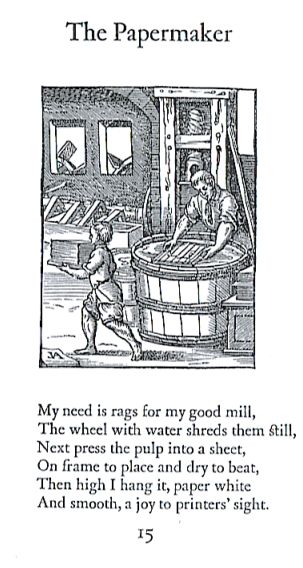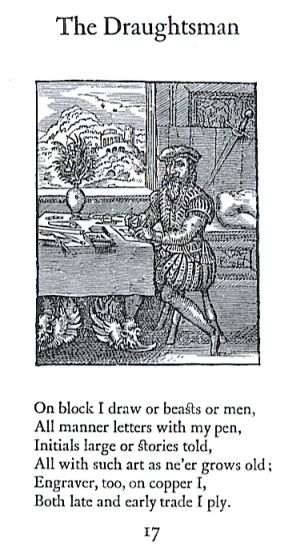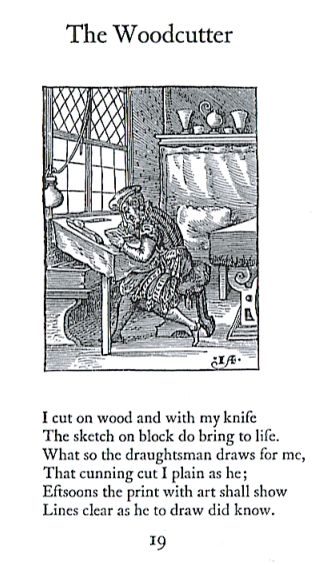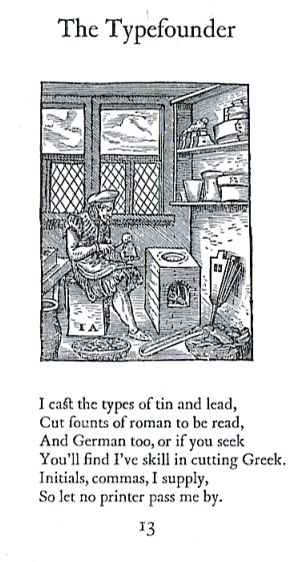A TRUE DESCRIPTION OF ALL TRADES
PUBLISHED IN FRANKFORT IN THE YEAR 1568
WITH SIX OF THE ILLUSTRATIONS BY JOBST AMMAN
MERGENTHALER LINOTYPE CO. BROOKLYN, NEW YORK 1930
In the year 1568 the renowned Frankfort publisher, Sigmund Feyerabend, printed at the press of Georg Raben a book called the Eygentliche Beschreibung aller Stande, being a collection of woodcuts illustrating all manner of trades and professions. Each woodcut is accompanied by doggerel verses written by the popular Nuremberg poet, Hans Sachs, and printed in Fraktur, which in the second half of the sixteenth century had become the standard type for all texts in the German language. The verses give much less information than the woodcuts, which illustrate the work of many different craftsmen in accurate detail. It is just that fact which has made the book famous; beecause the illustrations give exact informaation on the social and industrial life of the period, it is now a document of historical importance. The drawings were made by Jobst Amman and some of them are signed with his initials I. A. The book was a succcess and went through several editions, one with the verses in Latin written by one Schopperus and printed in italic. Jobst Amman was of Swiss birth, born at Zurich in 1539. His earliest known work is dated 1557 and was executed at Basle. In 1561 he moved to Nuremberg, where he lived for themost part down to his death in 1591. In 1562 Virgil Solis, the chief artist who worked for the busy publishing firm of Feyerabend, died, and Amman succeeded him. He soon became the most popular artist in Germany and with a prolific output. One of his pupils reported that Amman’s drawings over a period offour years would have filled a hayy wagon. His work for Feyerabend consisted of drawing his designs on woodblocks to be cut by other men. He was what is called on one of the illustrations in the Beschreibung alter Stande a “Reisser”. Occasionally also he would cut the blocks himself and in that case added to his initials a sketch of a wooddcutter’s knife, which was a common method of signifying a woodcutter. Amman was also an etcher and prepared many plates for Feyerabend. Among the material supplied to that publisher are many elaborate and overloaded title-borders and devices, which are a testimony to his painstaking industry rather than to his good taste. He supplied drawings for Feyerabend’s German Bible issued in 1564, a number of conventional portraits in ornate borders for a series illustrating the kings of France, and a series illustrating costumes of the day. This last work is a valuable document and shows him at his best, for he was rather an accurate delineator than an artist of imagination.
Among his other woodcuts are his illustrations to Livy, Josephus, and a book on war by L. Fronsperger. He did some excellent portraits, in particular an etching of his publisher, Feyerabend. The Beschreibung alter Stande contains, as the final verses tell us, one hundred and fourteen sketches. The first represents the Pope, followed by a Cardinal, a Bishop, the Emperor, a King, down to the more humble ranks. All imaginable crafts are illustrated, those of the metalworkers, weavers, carpenters, etc., many professions, the merchant, the pedlar, the soldier, the sailor, and all the cuts reveal some interesting details which show that the artist must have drawn from life and spared no pains to get the detail right.
The illustration of the itinerant musicians, for example, gives an exact picture of stringed instruments then in favour. Those relating to the art of printing which are here reproduced throw much light on the various processes in use in the sixteenth cenntury. The picture of a press shows very well how the inking was done with two pads, or ink-balls. The processes of papermaking and the various tools used in bookbinding are carefully portrayed. The picture of the typecaster with his furnace, bellows and mould is instructive, while in the case of the draughtsman the artist has had to confine himself to illustrating the dress and furniture of the day. This was his own profession, and perhaps he, too, worked with a pot of flowers on the table. In fact, it has been suggested that the draughtsman is a portrait of the artist himself.

The Papermaker:
My need is rags for my good mill,
The wheel with water shreds them still,
Next press the pulp into a sheet,
On frame to place and dry to beat,
Then high I hang it, paper white
And smooth, a joy to printers’ sight.

The Draughtsman:
On block I draw or beasts or men,
All manner letters with my pen,
Initials large or Stories told,
All with such art as ne’er grows old;
Engraver, too, on copper I,
Both late and early trade I ply.

The Woodcutter:
I cut on wood and with my knife
The sketch on block do bring to life.
What so the draughts man draws for me,
That cunning cut I plain as he;
Eftsoons the print with art shall show
Lines clear as he to draw did know.

The Typefounder:
I cast the types of tin and lead,
Cut founts of roman to be read,
And German too, or if you seek
You’ll find I’ve skill in cutting Greek.
Initials, commas, I supply,
So let no printer pass me by.

The Printer:
I, printer skilled, the ink apply,
Then down falls lever, page to print.
Thus I books cheap and good supply,
That all may buy and make no Stint.
Books, written once by hand of man,
In Mainz they first to print began.

The Bookbinder:
In binding books I have some skill,
In boards or vellum at your will,
Devout or worldly, large or small,
I fit with clasps and bind them all;
Oft-times also design do gild,
Thus keep my coffer filled.
